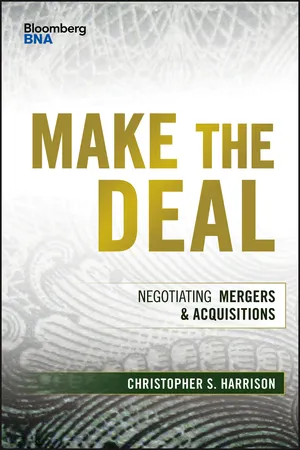
- English
- ePUB (mobile friendly)
- Available on iOS & Android
About this book
A comprehensive introduction to today's M&A strategies
Make the Deal is a direct and accessible guide to striking a powerful M&A deal. Merging business, finance, and law, this insightful examination of M&A strategy is designed to help you understand M&A negotiations and the ways in which the final outcome affects your financial future. A general overview of an acquisition agreement framework segues into a more detailed discussion of different deal structures, including stock sales, mergers, asset sales, and complex structures, giving you the information you need to know when each one applies best in practice. You'll gain insight into real-world negotiations and the delicate balancing act that occurs as each party attempts to maximize value and minimize risk, and learn the potential pitfalls that can occur. Negotiation statistics and samples from actual contracts back the war stories throughout, and reinforce the idea that there's no single perfect solution.
As a topic of study, M&A is constantly evolving; in practice, it changes at the speed of light. Staying ahead of the market is the single most critical element of making the best deal, and the strategy that worked for one deal most likely won't work for the next. Instead of simply providing a list of strategies that have worked in the past, this book shows you why they worked, so you can tailor your strategy specifically to your next deal.
- Learn how M&A contract terms affect economic outcomes
- Examine the techniques and mechanics of today's acquisition agreements
- Develop a legal framework that supports your business strategy
- Follow the ups and downs that arise in real-world cases
A successful M&A transaction requires both attention to detail and a big picture view, combined with skill, intellect, and ingenuity. Make the Deal brings it all together to show you how to run the table and come away with a win.
Frequently asked questions
- Essential is ideal for learners and professionals who enjoy exploring a wide range of subjects. Access the Essential Library with 800,000+ trusted titles and best-sellers across business, personal growth, and the humanities. Includes unlimited reading time and Standard Read Aloud voice.
- Complete: Perfect for advanced learners and researchers needing full, unrestricted access. Unlock 1.4M+ books across hundreds of subjects, including academic and specialized titles. The Complete Plan also includes advanced features like Premium Read Aloud and Research Assistant.
Please note we cannot support devices running on iOS 13 and Android 7 or earlier. Learn more about using the app.
Information
CHAPTER 1
Introduction to Deal-Making: Deal-Making in Practice
Looking back, I have come to realize that careful attention to transaction details played a critical role in the businesses I founded over the course of my career. Thinking strategically about potential outcomes—and setting the stage in the contract to navigate them in the future—was critical to my success.—Dr. Henry G. Jarecki
War Stories
War Story
The Market
THE MARKET
- Sample size. The smaller the sample, the more they can be influenced by outlier deals.
- Sample selection. Rarely do studies consider all available data. How they pick and choose affects the results.
- Period reviewed. Trends change, by definition. The period studied matters.
- Mix of deal types. Different deal types constitute their own market. More or less of one type skews the results.
Table of contents
- Cover
- Title Page
- Copyright
- About the Author
- Chapter 1: Introduction to Deal-Making: Deal-Making in Practice
- Chapter 2: Setting Up the Deal: Overview and Confidentiality Agreements
- Chapter 3: Setting Up the Deal: Key Provisions and Agreements
- Chapter 4: Architecture of the Acquisition Agreement
- Chapter 5: Purchase Price
- Chapter 6: Representations and Warranties
- Chapter 7: Covenants
- Chapter 8: Closing Conditions
- Chapter 9: Termination Rights
- Chapter 10: Material Adverse Effect
- Chapter 11: Equity and Debt Commitment Letters
- Chapter 12: Financing Risk
- Chapter 13: Topping a Public Merger
- Chapter 14: Indemnities
- Chapter 15: Dispute Resolution
- Chapter 16: Structuring M&A Deals
- Index
- EULA